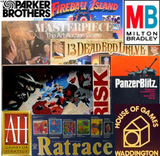Growing up in the 70s and watching TV was awesome, with shows like Battlestar Galactica, The Incredible Hulk, Space: 1999, Buck Rogers in the 25th Century, Mork & Mindy, Wonder Woman, The Shazam/Isis Hour, The Star Wars Holiday Special, Happy Days, The Bionic Woman, and The Six Million Dollar Man. Parker Brothers was quick to capitalize on the popularity of many of these shows within their own target demographic by releasing games based on each series. Some were terrible, the board game equivalent of shovelware, but one in particular was a classic – The Six Million Dollar Man: Bionic Crisis.
Bionic Crisis was invented by Paul J. Gruen, who invented such classics as This Game is Bonkers!, Gambler and Payday. He was also the game creator behind some of Parker Brothers’ television properties, such as Battlestar Galactica and Barney Miller with the 12th Precinct Gang, as well as the designer of some lesser known games, such as Voyage of the Dawn Treader and Dungeon Dice. Truly, the man was a prolific creator of board games (he passed away in 1993). For such an amazing talent, not a single picture of him can be found on the Internet – except his gravestone. What a crazy world we live in.
Bionic Crisis was a game that contained both elements of chance and deductive reasoning. To set up, each player took one of the four Console Boxes and inserted a Console Card into it. The red and yellow board pegs are placed somewhere where everyone can reach them. Then the deck of Bionic Circuit Cards was shuffled, and one was dealt to each player, who kept it hidden from his or her opponents. Finally, the deck of Number Cards was shuffled, with each player given three cards and the rest placed face down for everyone to draw from during gameplay. Once set up, the play began.
The object of the game was simple: be the first to use the Number Cards to duplicate the Bionic Circuit of the player on your left. Each turn a player called out a number from one of the Number Cards. If number was on his left-hand opponent’s Circuit Card as one of the ten red spaces, he got a red peg. If the number was adjacent to a red space, a yellow peg was given instead, and if the number completely missed the mark, then the player ended his turn empty-handed. (Yes, I realize you now want to chant, “You sank my battleship!”…but control yourself.) This process continued until the Bionic Circuit Card was revealed.
A shortcut to winning the game was to simply map out the entire Bionic Circuit Card by making a guess. If you were correct, you won the game. However, if you were wrong – even by a single circuit – you were no longer able to win, though you still had to answer questions from your opponent. This consequence were so severe that guesses were rarely worth the risk. We had a House Rule that granted up to three guesses to each player, which added more deduction and less random chance to the gameplay.
Parker Brothers labeled the box for ages 7 to 14, which is quite accurate, as Bionic Crisis was clearly not an adult’s strategy game. However, the game still brings back fond childhood gaming memories, and must be judged for what it was: a child’s game based on a television property. It was fun then, and if you can bring back your inner child, it can be fun to play even today. Only the best classic games can do that!
Filed under: Board Games, The Best Classic Board Games | Tagged: 1975, best classic board games, bionic crisis, parker brothers, six million dollar man | Leave a comment »





























